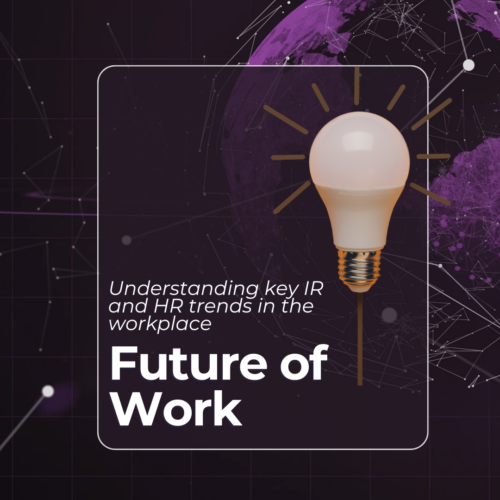
HR & Employment Law in 2025: What does the Future of Work Look Like?
As businesses navigate ever-changing industrial relations (IR) and human resources (HR), it’s clear that we’re in a transitional era for employment and workplace culture. The past year has introduced sweeping changes, and the year ahead is set to solidify many of these transformations. But these developments aren’t just isolated policy shifts, they’re part of a broader movement reshaping how we define work, employment relationships, and corporate responsibility. So, what do these trends tell us about where we’re headed? What does the rise of AI, changes to casual work, the criminalisation of wage theft, and the increasing power of employees in workplace negotiations signal about the future of work? Through these changes, and the ways in which we’ve seen some of these changes impact the workplaces we closely work with, we can see that a big picture is coming into focus: we’re moving towards a workplace model where transparency, fairness, and long-term sustainability take centre stage. There’s a growing recognition of just how much of an impact our ways of working have on us and those around us, and so the question for businesses is no longer whether they need to adapt, it’s about how quickly they can do so. 2024: A Year that Redefined Work and Employment Over the past year, we’ve seen some major shifts in how work is structured, how workers are protected, and how businesses are held accountable. But these changes aren’t happening in a vacuum. They are part of a broader trend of regulatory bodies stepping in to shape a fairer, more balanced workforce, one that prioritises equity, stability, and employee well-being over short-term business flexibility. The Rise of AI in HR – The Automation Boom and the Ethical Reckoning The integration of AI into HR has been one of the most rapid shifts in workforce management. Businesses have increasingly used AI to screen resumes, track employee productivity, and forecast workforce needs. AI has brought efficiency, but it has also sparked serious ethical concerns. We’ve seen concerns about algorithmic bias, lack of transparency, and excessive workplace surveillance gain increasing. It’s a whole new world and it’s seen both employees and regulators alike pushing back, questioning whether AI-driven decisions can truly be fair and whether companies should have greater accountability in how these technologies are applied. So, where to from here? Expect new regulations around AI use in HR, requiring businesses to be more transparent about how decisions are made and ensure AI doesn’t reinforce existing biases. And as we continue to understand and integrate this new world into our current modes of work, you can also expect to see a push towards a human-centered approach to technology adoption, where innovation is balanced with ethical responsibility. The Right to Disconnect Arguably one of the most buzzworthy changes in 2024 was the introduction of the Right to Disconnect in August 2024. Buzzworthy because it was seen a more than just a workplace policy shift. It reflected a larger cultural change in how we view work. Employees are no longer willing to sacrifice their personal time for the expectation of constant availability, and the law now supports that stance. The Right to Disconnect provisions give employees the right to refuse unreasonable work-related contact outside of their normal hours, and early disputes in the Fair Work Commission are already setting important precedents on what is considered “reasonable” contact. This signals a fundamental shift in workplace expectations. Employers who fail to respect these new boundaries won’t just risk legal disputes, they’ll risk losing talent in a market where flexibility and well-being are top priorities for workers. The larger trend? A redefinition of work-life balance as a fundamental right, not just a company perk. Businesses that embrace this shift – through setting clear communication policies, encouraging better work-life balance, and respecting employee boundaries – will be the ones that retain and attract top talent in the years to come. Criminalising Wage Theft Day 1 of 2025 and we’ve already had one of this year’s most striking changes with the criminalisation of wage theft, which introduces a new era of accountability for businesses. Under the new laws, intentional underpayment of wages, allowances, or superannuation is now a criminal offense, with severe penalties for employers who fail to comply. Business owners, executives, and HR professionals can now be personally liable, facing up to 10 years in prison and fines of up to $8.25 million or three times the underpayment amount. The broader implication here is clear: wage theft is no longer seen as a “mistake” or a compliance issue and is now treated as a serious financial crime. We see this as marking a turning point in how employment law is enforced. Instead of waiting for companies to self-correct, regulators are taking a proactive and punitive approach. This signals a future where businesses can no longer afford to be reactive about compliance, they’ll have to be proactive in ensuring they are following best practices at all times. Casual Work & The Future of Employment For years, casual work in Australia has operated in a rather grey area, giving employers flexibility while often leaving workers without job security. But as of August 2024, casual work is now defined more clearly: a worker can only be classified as casual if there is no firm commitment to ongoing work. This means that even if an employee is on a casual contract, their actual work patterns and expectations matter more in determining whether they are entitled to permanent employment status. At the same time, 2024 also saw gig economy workers gaining greater protections, bringing them closer to traditional employees in terms of rights and entitlements. New laws now ensure that gig workers can’t be unfairly deactivated from platforms and have the right to collective bargaining, allowing them to negotiate better pay and conditions. Looking at the bigger picture here, we’re seeing a slow but steady erosion of the traditional “casual work” model in favour of more structured, stable employment arrangements. As more workers demand job security and benefits, businesses




